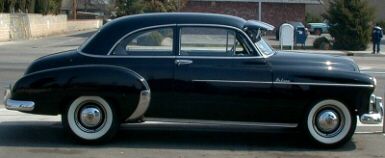
SAN FRANCISCO: In 1950, Chevrolet Motor Division set out to put the icing on the cake
they had baked the year before. The 1949 product line had clothed a standard post war
chassis in its first new bodywork since the early Forties. A sleek new smooth sided front
clip faded back into voluptuous teardrop rear fenders. Fastback roof styles had become so
popular that they were available in both two and four door configurations. This very
pleasing shape would be the mainstay of GM styling, on all lines, through the mid-Fifties.
The former, lower line, Stylemaster series was now called the Special
Series and the Fleetmaster became the Deluxe. The Fleetline name, rather than denoting the
top of the line as in the past, was given to all fastback models in both the Special and
Deluxe series. Body styles included two and four door sedans in both fastback and
trunkback styles, A shorter topped, two door Sport Coupe that was also available as a two
passenger business coupe in the Special series. A classy convertible, a partially wooden
framed station wagon, and a well shaped sedan delivery complete the line.
Mechanically, these cars retained the tried and true 216 cube, OHV six
that had been with Chevrolet since the late Twenties. The three-on-the-tree, three speed
gearbox lost the silly vacuum assist option and 15 inch wheels became standard. Though the
1949 models look longer and lower than the '48, the wheelbase is actually an inch shorter!
This was the biggest year ever for Chevrolet with 1,109,958 units sold.
Big news for 1950 was the new Bel Air hardtop and the availability of
the Power-Glide automatic transmission, two firsts in the low price arena. The hardtop
concept, introduced by GM in 1949 on the Buick, was so popular that all of the General's
lines had one for 1950. These cars used the lower windscreens and frameless doors from the
convertible and combined them with a gently sloping top with a wrap around rear window.
The two speed Power-Glide automatic was powered by a brand new and more
powerful six. Based on the larger Chevy truck 235 cu. in. block, the new powerplant
featured hydraulic valve lifters and a 6.7:1 compression ratio that pushed it up to 105
horsepower.
On the outside, changes were minimal for 1950. The
"divisions" in the lower grill disappeared and the hubcap emblem color changed.
The wood portion of the station wagon was replaced with a similar looking all steel
construction and sales jumped substantially. In fact, this was another record sales year
for Chevrolet.
The Writers' First Car
My parents discovered that I was a serious motorhead around the time
that I learned to talk. I believe that my first three words were Mama, Dad and Chevy. By
the age of three, I could name all of the cars on the streets of San Francisco, even the
prewar models that were still pretty plentiful in the early fifties. This was quite
surprising to my folks, who didn't even own a car until 1954. My father was so
un-automotive that he would call the Auto Club to change flat tires, let alone anything
more complicated.
By the age of thirteen, our family had moved to the suburbs and Mom
decided that, since I had been building model cars for over five years, it stood to reason
that I should graduate to a non-running full sized car to play with. Our neighbor Mr.
Brown had a lovely pale green '50 Chevy Deluxe Club Coupe that had stopped running after a
series of loud clanging noises from the engine bay. For the sum of just $30 the old
"Stovebolt" was towed to our driveway.
After removing the sump, my friend John and I discovered that the
number three piston had exploded and the rod had somehow become separated with its cap and
was now wrapped around the crank journal like a link of chain. We gave up any hope of
resurrecting the old 216 and concentrated on polishing and waxing the near perfect
exterior finish and painting things glossy black as was the style du jour. My father's
store sold spray paint, and I must have absconded with cases of it to heavily coat the
wheels, chassis and inside the wheel arches.
My big break came late one evening when another neighbor, Mr. Wise was
driving his 1954 Chevy estate home from an evening at the tavern in an alcoholic haze and
stalled it on the Southern Pacific track crossing a few minutes before the 11:00 PM
freight run to LA was due. He got out but the '54 got "T-boned" and reshaped
into a permanent right hand turn. I purchased the remains for $15 and its sweet running
235 cube, hydraulic lifter six soon rested in the club coupe's frame.
Yes, we did get it running, and pretty well at that. But with no
registration, insurance, or driver's license the old Chevy was about as useful as a model
car. One night when my parents were out on the town, we took it for a late night drive but
I was so nervous about getting caught that I came home early and didn't enjoy it. OK,
maybe a little.
It was at this point that I'd discovered girls and with older friends
who were legally driving, the Fifty started collecting dust in the garage. It eventually
was sold to a young man who drove it to college and I started saving for my first
"real" car. While I never got to use my little club coupe, I learned a lot about
cars in general and developed an affection for old Chevrolets that lasts to this day. By
Rick Feibusch © AutoWire.Net - San Francisco

Byline: By Rick Feibusch © AutoWire.Net - San Francisco
Column Name: The Classic Drive
Topic: The 1950 Chevrolets
Word Count: 950
Photo Caption: 1950 Chevrolet
Photo Credits: Classic Car Archives
Series #: 1999 - 51


|
